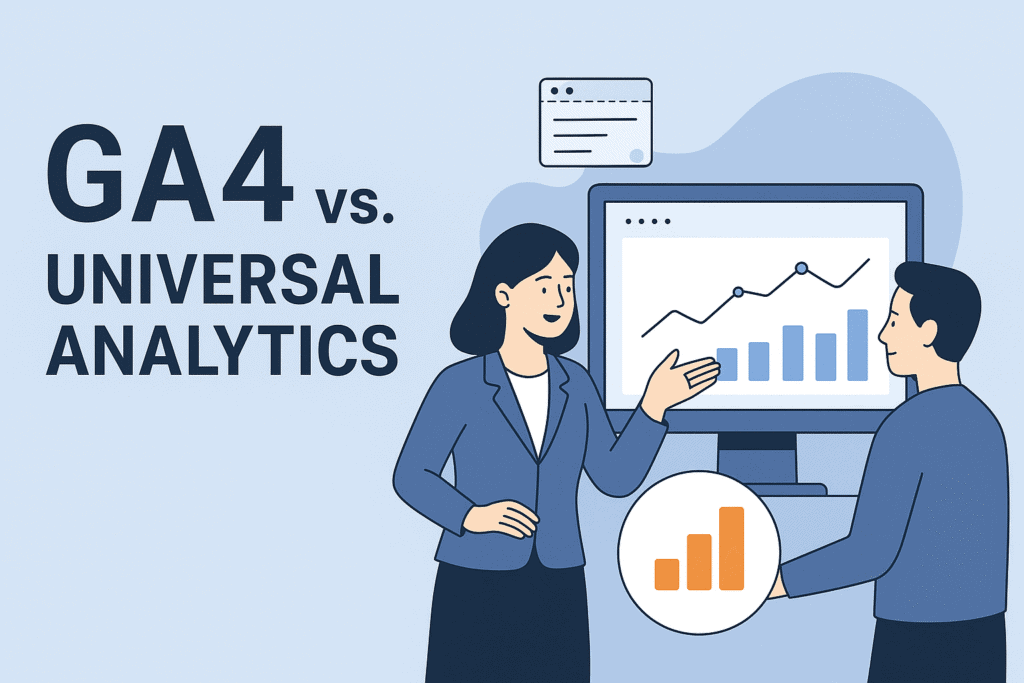In 2023, Google officially sunset Universal Analytics (UA), making Google Analytics 4 (GA4) the default analytics platform. While many marketers made the switch out of necessity, it wasn’t until 2025 that the real differences became clear.
For modern marketers, understanding GA4 vs Universal Analytics isn’t just a technical exercise — it’s about how strategy, KPIs, and reporting must evolve in a privacy-first, cross-platform world.
From Sessions to Events: A New Way of Thinking
The most fundamental change in GA4 vs Universal Analytics is the data model.
- Universal Analytics (UA): Organized around sessions and pageviews.
- GA4: Built entirely on events and parameters.
This means instead of thinking in terms of “visits” and “page counts,” marketers now focus on user actions (clicks, scrolls, downloads, purchases) and enrich them with context (location, device, campaign).
👉 For example, in GA4, a “purchase” isn’t just a hit within a session — it’s a structured event with details like transaction_id, currency, and items.
Attribution: Last-Click Is No Longer Default
UA defaulted to last non-direct click attribution, which often undervalued top-funnel campaigns.
In contrast, GA4 now defaults to data-driven attribution (DDA). This model uses machine learning to assign credit across touchpoints, giving a more accurate picture of which channels influence conversions.
For marketers in 2025, this shift means:
- Paid media ROI looks different — awareness campaigns show stronger impact.
- Email and retargeting performance must be re-evaluated.
- Cross-channel budget allocation requires deeper analysis.
Reporting and UI Changes
Marketers used to the standard UA reports (Audience, Acquisition, Behavior, Conversions) often feel lost in GA4.
Here’s what changed:
- Explorations: Replaces many UA reports, allowing drag-and-drop analysis.
- Engagement metrics: “Bounce rate” is gone; now replaced by engagement rate.
- Custom reports: GA4 forces marketers to define KPIs explicitly rather than relying on predefined dashboards.
Privacy and Consent
By 2025, privacy regulations (GDPR, CCPA, DMA) are even stricter. UA was never designed for this world.
GA4 includes:
- Consent Mode v2: Modeling conversions even when users opt out of tracking.
- First-party data focus: GA4 integrates smoothly with server-side tagging and BigQuery exports for durable data strategies.
- Data retention limits: Shorter default retention, with compliance baked in.
For marketers, this means GA4 is not just an upgrade — it’s a necessity to stay compliant while still getting actionable insights.
Migration Challenges in 2025
Despite GA4’s advantages, many companies still struggle with:
- Broken tracking due to duplicate pageviews in WordPress/GTM setups.
- Misconfigured events vs. conversions leading to under-reporting.
- Teams relying too heavily on modeled data instead of validated tracking.
This is why partnering with analytics experts has become essential.
How MetricByte Consulting Helps Marketers Transition
At MetricByte Consulting, we’ve helped enterprises and SMEs alike navigate GA4 migrations. Our services include:
- GA4 property structure optimization for scalable reporting.
- Event taxonomy design to ensure clean, consistent data.
- Attribution modeling workshops to realign budgets with GA4 insights.
- GTM/Launch debugging to eliminate data duplication and conflicts.
Our QA-first approach ensures your GA4 setup delivers data you can trust.
Final Thoughts
The debate of GA4 vs Universal Analytics is no longer about preference — it’s about adapting to a world where users, privacy, and actions define success.
For marketers, GA4 is both a challenge and an opportunity. Those who embrace its event-driven mindset, data-driven attribution, and privacy-first design will have a clear competitive edge in 2025 and beyond.
👉 Ready to ensure your GA4 setup is accurate and growth-ready? Contact MetricByte Consulting today.
